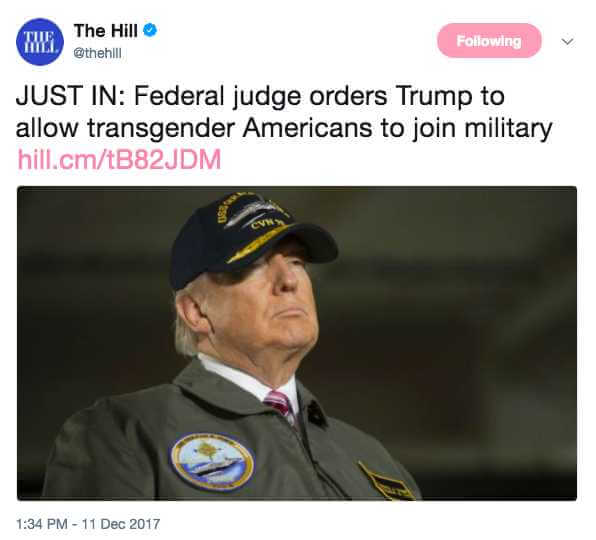There can be no more delays to the Pentagon allowing transgender recruits in the U.S. Military, and transgender recruits can enlist starting Jan. 1, 2018, a federal judge has ruled. This comes after the Trump Administration last week tried to delay the hiring of transgender recruits.

Transgender ban (Twitter)
Last week, the Pentagon said Tuesday it is preparing to accept transgender military recruits in the New Year. But the White House on Wednesday asked a federal court to block that measure and delay hiring transgender recruits.
Now, there can be no more delays, opening the door for transgender people to enlist and join the U.S. Military in less than a month.
President Donald Trump in July sent three tweets declaring that he was blocking transgender troops from the military, and that they could not serve “in any capacity.”
A U.S. District Court judge partially blocked Trump’s transgender troop ban and ruled in late October that there can be no changes to the U.S. Military’s transgender policy while there is pending litigation against the proposed ban that is being reviewed in court. The judge, Colleen Kollar-Kotelly, also denied a motion to block the ban on gender reassignment funds.
And, most recently, a federal district court judge in Maryland ruled that the U.S. must continue to fund sex-reassignment surgeries for transgender service members in the military, citing that they have “already suffered harmful consequences,” after President Trump called for a transgender ban in the military.
The Trump Administration can’t deny funding for certain medical care for transgender service members, District Judge Marvin Garbis said.
President Trump in August signed a directive that instructed the Pentagon to prohibit transgender people from joining the military, and it gave Defense Secretary Jim Mattis the power to remove any transgender service member based on deployability.
On July 26, Trump announced the ban in three tweets that seemingly blindsided officials and outraged many people.
“After consultation with my Generals and military experts, please be advised that the United States Government will not accept or allow Transgender individuals to serve in any capacity in the U.S. Military,” Trump had tweeted.
“Our military must be focused on decisive and overwhelming victory and cannot be burdened with the tremendous medical costs and disruption that transgender in the military would entail,” he said.
Mattis reportedly had six months from August – which would put the end date sometime in or around February – to prepare to implement the White House’s directive.
After the President’s directive was released, Mattis in August said that transgender troops will continue to serve in the U.S. military, pending the results of a study from experts Mattis will select who will provide advice on Trump’s recent memorandum.
The American Civil Liberties Union (ACLU) in August announced it was suing President Trump over his transgender ban for the U.S. military.



